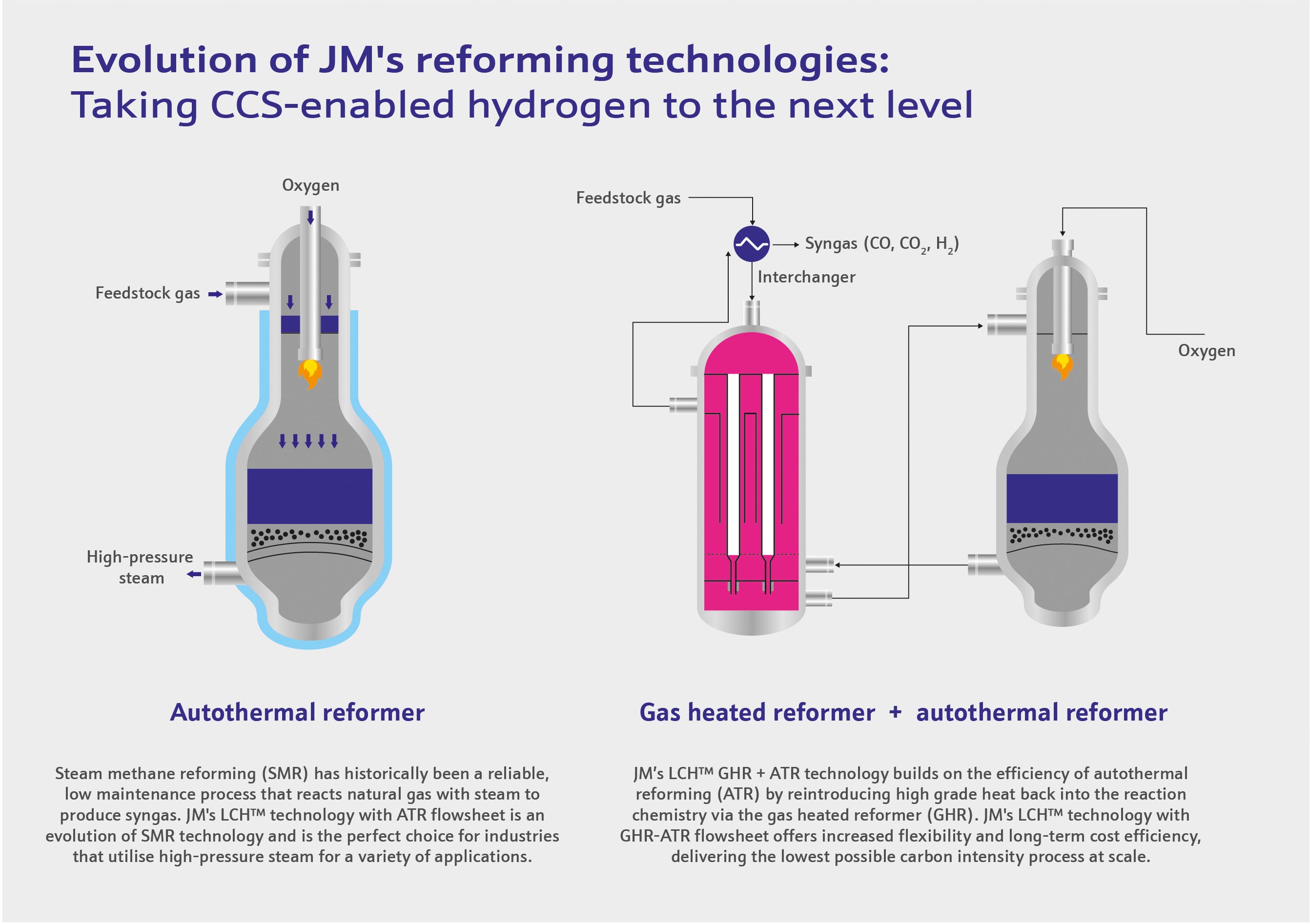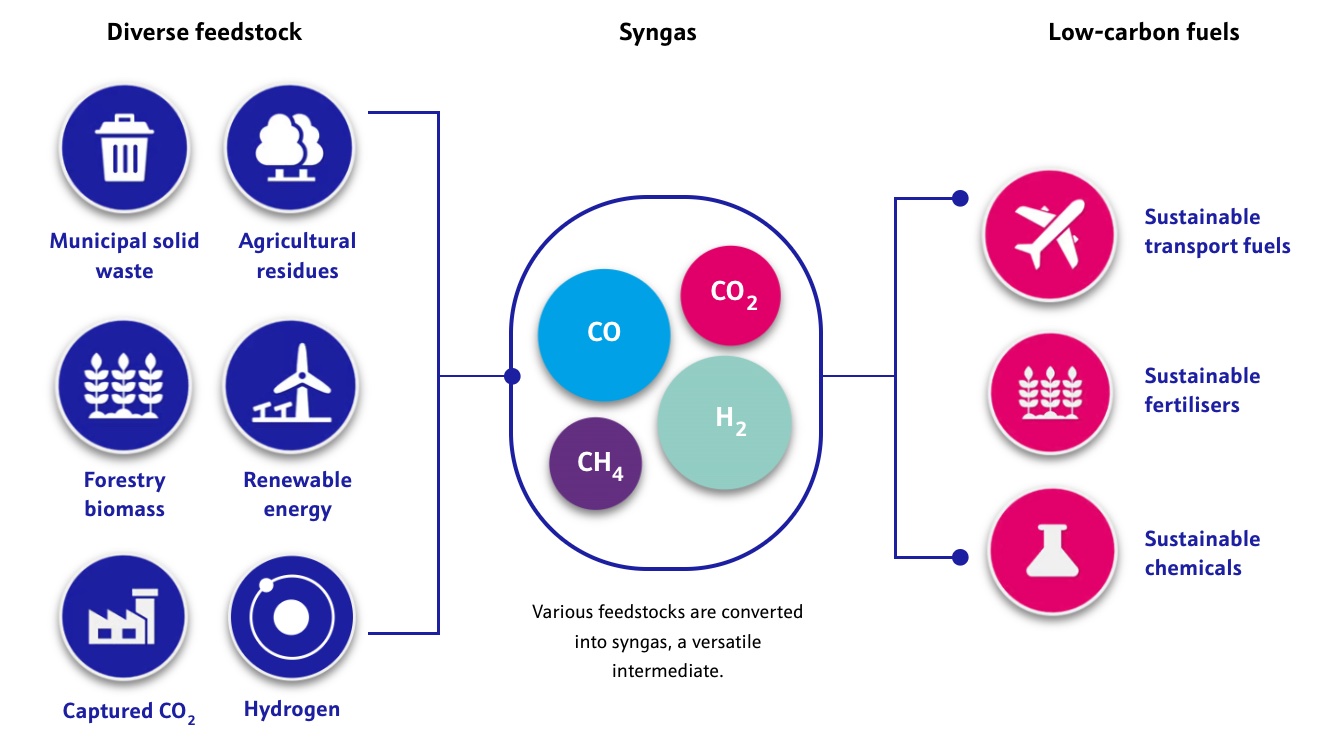
An illustration of BP’s H2 Teesside hydrogen project in the U.K. (Source: Johnson Matthey)
Chemicals company Johnson Matthey (JM) has been in existence longer than the electric bulb, the telephone and even rubber bands, but the more than 200-year-old company is keeping up with changing times—and changing feedstocks.
With synthesis gas (syngas) at its core, the London-based company’s catalyst technologies business is transforming feedstock into hydrogen, methanol and sustainable aviation fuel (SAF), among other products.
Syngas is a mixture of hydrogen and carbon monoxide along with some CO2. Traditionally, JM’s focus has been on converting fossil fuel feedstocks; however, the company is now transforming more biomass into molecules.

“When customers come with alternative feedstocks, we will find routes to convert those into syngas. We can do that alone or usually with partners,” Maurits van Tol, CEO of catalyst technologies for Johnson Matthey, told Hart Energy. “When the syngas is there, then we can still make the methanol or the ammonia or hydrogen, whatever they want to make, or the synthetic aviation fuel.”
Most of the syngas produced today is made from fossil resources through processes such as steam methane reforming and coal gasification. However, the global drive to lower greenhouse-gas emissions is stimulating more interest in biomass and the large-scale technologies that can make it happen.
Renewable syngas could play an essential role in helping industries lower emissions profiles. It is considered a basic building block for a variety of chemicals, polymers, ammonia and methanol.

Teaming tech
JM converts syngas into methanol and methane with the help of catalysts. It uses captured CO2 from bio-SAF manufacturing and converts it into syngas. The company also uses syngas in the hydrogen and blue ammonia process.
“About 40% of all the chemicals in the world are produced through syngas, and that is where we are the number one player in the world,” van Tol said. “Most hydrogen in the world is produced using Johnson Matthew technology.”
Some of the world’s biggest energy and fuel producers are tapping such technology.
JM’s LCH technology, which the company says couples a gas-heated reformer with an autothermal reformer, offers the lowest natural gas usage commercially available today and can capture up to 99% of CO2 produced.
BP licensed the LCH tech for its H2Teesside project—one of the largest hydrogen projects being developed in the U.K. BP aims to produce about 160,000 tonnes of low-carbon hydrogen per annum by 2030.
JM is collaborating with Thyssenkrupp Uhde on an integrated carbon capture and storage-based ammonia production technology. JM has provided ammonia catalysts to Thyssenkrupp Uhde for about 25 years, van Tol said, adding that Thyssenkrupp Uhde is at the fore in ammonia technology.
Partnerships are vital in accelerating the deployment of technology, he said. “We have a very broad portfolio, but it never covers everything. So, you need to team up with others in the value chain like we do.”
Teaming with technology providers allows each player to bring its expertise to a project while reducing the number of companies a customer has to deal with, he said. “The back office takes care of the alignment and integration of those various technologies.” Rather than each company operating in a silo, trying to invent and cover the entire portfolio, “why not team up with someone who has your missing pieces of the puzzle? We’ll go a lot faster.”
Meeting demand
That could hold true for parts of the business that are seeing great demand. For JM, that’s blue hydrogen and blue ammonia. Blue indicates natural gas is used as a feedstock, coupled with carbon capture to lower emissions.

More than 90% of the ammonia produced in the U.S. uses natural gas as feedstock, according to the Rocky Mountain Institute (RMI). However, only one blue ammonia plant is in operation with another under construction.
“Ammonia is a very important molecule right now for fertilizers and other applications. Add to that … people are thinking about using it as a fuel. So that is the chain that is probably most advanced,” he said.
Fischer-Tropsch technology to produce low carbon intensity fuels—in particular jet fuel— is also gaining interest amongst industry players. “In many areas around the world, you see mandates that are in place to at least blend a little bit of low carbon fuel into the jet fuel pool,” he said.
JM’s catalyst-reliant Fischer Tropsch CANS technology, co-developed with BP, was selected this year for DG Fuels’ proposed $4 billion SAF plant in Louisiana. Catalysts, or substances that speed up chemical reactions, are seen as crucial to production of lower-carbon energy sources such as biofuels and hydrogen, as well as capturing CO2 and reducing emissions.
In the future, he sees more focus on utilizing CO2 molecules instead of storing them underground. Van Tol pointed out that Repsol and Aramco are using JM’s HyCOgen technology to convert CO2 from flue gas from a refinery. The CO2 is captured and combined with green hydrogen to make syngas, which is then converted to jet fuel, he explained.
So, it all comes back to syngas?
“A lot does to be very honest,” he said. “Because all these molecules, the original raw materials, varied municipal solid waste, CO2, biomass, but also coal, you can convert it into syngas. … Syngas is really important and will remain very, very important.”

Looking ahead
While defined pathway to low-carbon fuels are set and technologies are in place, government support is still needed to help scale nascent technologies, van Tol said, referring to hydrogen.
“On a cost/price level, you can’t compete in most cases with this very well-established fossil-based industry. So, it needs some assistance via legislation, contract for difference, whatever it is. There are many tools in the toolbox that governments can use,” he said. However, clear and stable legislation must be implemented. “These are large capital projects that our customers [are] inventing. They want to have security. They want to have a bankable proposition that is de-risked as much as they can.”
Other needs include harmonization of norms; pipe diameters and valves so molecules can be shipped around the world efficiently; and strengthening the supply chain, he said. Large-scale projects require a great deal of equipment that is not always available at the scale needed.
“When we only support the final use of the product, we are missing the point,” van Tol said. “We need to look at the entire value chain and see what other support mechanisms should be in place,” he said, using compressors and other equipment as examples. “It’s always the weakest link we need to look at and need to help to bring that to scale.”
Being feedstock agnostic, JM sees its portfolio as well suited for the transformation. Fossil is not going away but the potential to convert biomass, including in areas without much oil and gas, has opened up opportunities, he said.
“It opens up … a customer portfolio that we didn’t have access to in the past because the demand was not there to convert biomass into jet fuel. Now it is,” van Tol said. “So, in that sense, I believe that our future is very bright because we are in the sweet spot. A lot, as you say, goes via syngas. That’s our play, and we have some nice plays around that as well.”
Recommended Reading
Ring May Drill—or Sell—Barnett, Devonian Assets in Eastern Permian
2025-03-07 - Ring Energy could look to drill—or sell—Barnett and Devonian horizontal locations on the eastern side of the Permian’s Central Basin Platform. Major E&Ps are testing and tinkering on Barnett well designs nearby.
Utica Oil Player Ascent Resources ‘Considering’ an IPO
2025-03-07 - The 12-year-old privately held E&P Ascent Resources produced 2.2 Bcfe/d in the fourth quarter, including 14% liquids from the liquids-rich eastern Ohio Utica.
Williams to Invest $1.6B for On-Site Power Project with Mystery Company
2025-03-07 - Williams Cos. did not name the customer or the location of the power project in a regulatory filing.
Energy Transition in Motion (Week of March 7, 2025)
2025-03-07 - Here is a look at some of this week’s renewable energy news, including Tesla’s plans to build a battery storage megafactory near Houston.
US Drillers Cut Oil, Gas Rigs for First Time in Six Weeks
2025-03-07 - Baker Hughes said this week's decline puts the total rig count down 30, or 5% below this time last year.
Comments
Add new comment
This conversation is moderated according to Hart Energy community rules. Please read the rules before joining the discussion. If you’re experiencing any technical problems, please contact our customer care team.





